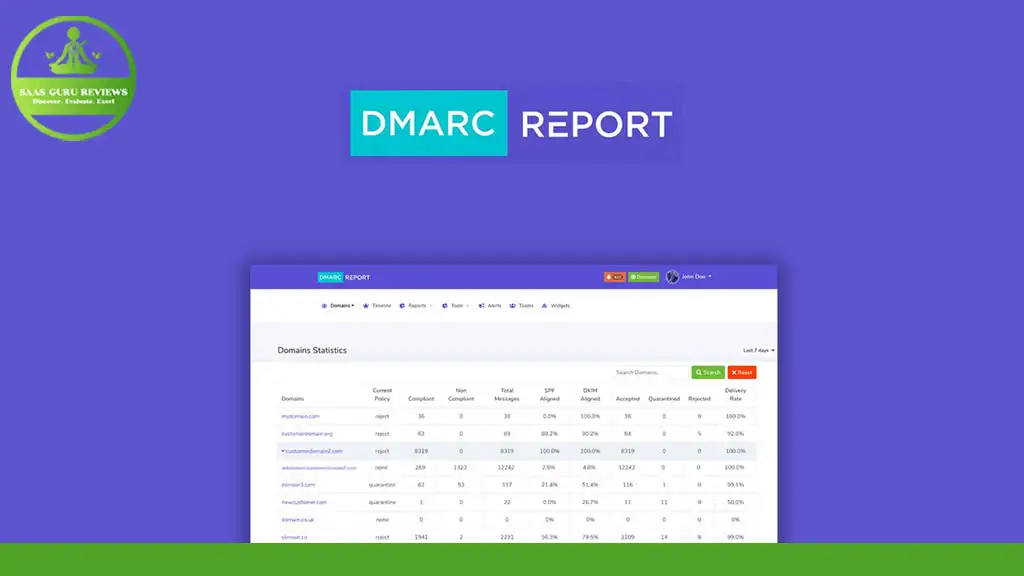DMARC (Domain-based Message Authentication, Reporting & Conformance) is an email authentication protocol that helps protect your domain from being used in phishing and spoofing attacks. This article is worth reading because it provides a detailed explanation of DMARC, its importance, and how to implement it effectively. Whether you’re a beginner or an experienced professional, you’ll gain valuable insights into enhancing your email security.
Article Outline
- What is DMARC?
- How DMARC Works
- The Importance of DMARC Implementation
- Setting Up Your DMARC Record
- Understanding DMARC Reports
- Benefits of DMARC
- DMARC and Email Security
- Common Challenges in DMARC Implementation
- DMARC Monitoring and Maintenance
- EasyDMARC: A User-Friendly DMARC Solution
What is DMARC?
DMARC (Domain-based Message Authentication, Reporting & Conformance) is an email authentication protocol designed to give email domain owners the ability to protect their domain from unauthorized use. DMARC builds on the established SPF (Sender Policy Framework) and DKIM (DomainKeys Identified Mail) protocols, adding an important reporting function.
Mature competitors like Valimail, EasyDMARC, ZeroBounce, Red Sift OnDMARC, and PowerDMARC have been in the market for a while, offering robust solutions. EasyDMARC, launched in 2018 by founder Brad Slavin, has garnered 4.9 stars from 193 reviews and boasts a website traffic of 691.34. Their support is available and highly responsive. Check out their website and YouTube channel for more information.
How DMARC Works
DMARC works by aligning SPF and DKIM mechanisms to validate the authenticity of an email. When an email is sent, the receiving server checks the SPF and DKIM records to ensure that the email is legitimate. If the email passes these checks, it is delivered to the recipient’s inbox. If it fails, the receiving server follows the DMARC policy set by the domain owner.
Competitors like Valimail, EasyDMARC, ZeroBounce, Red Sift OnDMARC, and PowerDMARC are well ahead in offering comprehensive DMARC solutions. EasyDMARC, for instance, provides a user-friendly interface with 4.9 stars and 193 reviews. Their support is available and effective, and they have been operational since 2018.
The Importance of DMARC Implementation
Implementing DMARC is crucial for protecting your domain from phishing and spoofing attacks. By setting up a DMARC policy, you can prevent malicious actors from using your domain to send fraudulent emails. This not only protects your brand reputation but also enhances email deliverability.
Valimail, EasyDMARC, ZeroBounce, Red Sift OnDMARC, and PowerDMARC are some of the mature competitors in this space. EasyDMARC, founded by Brad Slavin in 2018, has a stellar rating of 4.9 stars from 193 reviews. Their support is readily available and highly responsive.
Setting Up Your DMARC Record
Setting up a DMARC record involves adding a TXT record to your DNS settings. This record specifies the DMARC policy you want to implement, such as “none,” “quarantine,” or “reject.” It also includes email addresses where you want to receive aggregate and forensic reports.
Competitors like Valimail, EasyDMARC, ZeroBounce, Red Sift OnDMARC, and PowerDMARC offer detailed guides and support for setting up DMARC records. EasyDMARC, which has been operational since 2018, offers a user-friendly interface and excellent support. They have a rating of 4.9 stars from 193 reviews.
Understanding DMARC Reports
DMARC reports come in two types: aggregate reports and forensic reports. Aggregate reports provide a summary of email authentication results, while forensic reports offer detailed information about emails that failed authentication. These reports are crucial for monitoring your DMARC implementation and making necessary adjustments.
Valimail, EasyDMARC, ZeroBounce, Red Sift OnDMARC, and PowerDMARC provide robust reporting features. EasyDMARC, with a rating of 4.9 stars from 193 reviews, offers comprehensive reporting tools. Their support is available and effective, and they have been in the market since 2018.
Benefits of DMARC
The benefits of DMARC are manifold. It helps in improving email deliverability, protecting your domain from phishing and spoofing attacks, and providing valuable insights through reports. By implementing DMARC, you can enhance your overall email security and protect your brand reputation.
Competitors like Valimail, EasyDMARC, ZeroBounce, Red Sift OnDMARC, and PowerDMARC offer extensive benefits. EasyDMARC, launched in 2018, has a high rating of 4.9 stars from 193 reviews. Their support is readily available and highly responsive.
DMARC and Email Security
DMARC plays a crucial role in email security by ensuring that only authorized emails are delivered to recipients. It helps in preventing phishing and spoofing attacks, thereby protecting sensitive information and maintaining the integrity of your email communications.
Valimail, EasyDMARC, ZeroBounce, Red Sift OnDMARC, and PowerDMARC are leaders in providing email security solutions. EasyDMARC, founded by Brad Slavin in 2018, has a stellar rating of 4.9 stars from 193 reviews. Their support is available and effective.
Common Challenges in DMARC Implementation
Implementing DMARC can come with its own set of challenges, such as configuring DNS settings correctly, interpreting DMARC reports, and maintaining ongoing monitoring. However, with the right tools and support, these challenges can be effectively managed.
Competitors like Valimail, EasyDMARC, ZeroBounce, Red Sift OnDMARC, and PowerDMARC offer solutions to these challenges. EasyDMARC, which has been operational since 2018, provides a user-friendly interface and excellent support. They have a rating of 4.9 stars from 193 reviews.
DMARC Monitoring and Maintenance
Monitoring and maintaining your DMARC implementation is crucial for ensuring its effectiveness. Regularly review your DMARC reports, make necessary adjustments to your policy, and stay updated with any changes in email authentication protocols.
Valimail, EasyDMARC, ZeroBounce, Red Sift OnDMARC, and PowerDMARC provide robust monitoring and maintenance solutions. EasyDMARC, with a rating of 4.9 stars from 193 reviews, offers comprehensive monitoring tools. Their support is available and effective, and they have been in the market since 2018.
EasyDMARC: A User-Friendly DMARC Solution
EasyDMARC offers a user-friendly solution for implementing and managing DMARC. With features like easy-to-understand reports, comprehensive monitoring tools, and excellent support, EasyDMARC makes DMARC implementation hassle-free.
Competitors like Valimail, EasyDMARC, ZeroBounce, Red Sift OnDMARC, and PowerDMARC are well-established in the market. EasyDMARC, founded by Brad Slavin in 2018, has a high rating of 4.9 stars from 193 reviews. Their support is readily available and highly responsive. For more details, visit their website.
Summary
- What is DMARC?: An email authentication protocol that protects your domain from phishing and spoofing.
- How DMARC Works: Aligns SPF and DKIM mechanisms to validate email authenticity.
- Importance of DMARC Implementation: Essential for protecting your domain and enhancing email deliverability.
- Setting Up Your DMARC Record: Involves adding a TXT record to your DNS settings.
- Understanding DMARC Reports: Aggregate and forensic reports provide valuable insights.
- Benefits of DMARC: Improves email security, deliverability, and protects brand reputation.
- DMARC and Email Security: Prevents phishing and spoofing attacks.
- Common Challenges in DMARC Implementation: Configuring DNS settings, interpreting reports, and ongoing monitoring.
- DMARC Monitoring and Maintenance: Regular review and adjustments are crucial.
- EasyDMARC: A user-friendly solution with excellent support and comprehensive features.
For more detailed information, visit EasyDMARC’s website and their YouTube channel.



